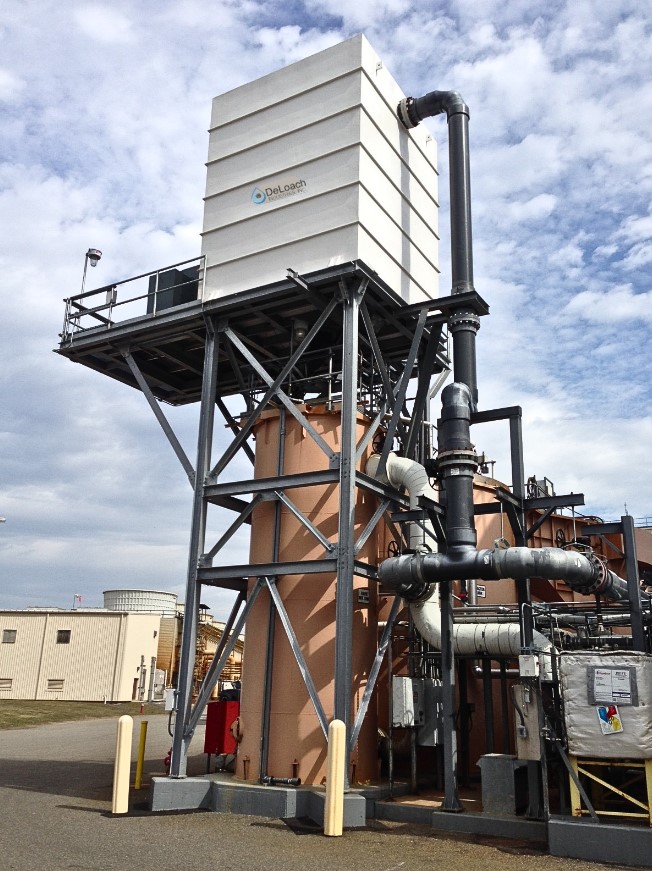Air Stripping VOC Removal
Enhancing Water Treatment with the Power of Air Strippers: Effective VOC Elimination

Water contamination is a critical concern, especially in municipal and industrial settings. To address this challenge, WES Industries specializes in designing, constructing, and applying air stripping technology. Air stripping involves passing air through contaminated water to remove volatile organic compounds (VOCs) and other pollutants.
We’ll identify the types of VOCs found in water and their health risks, why companies should use air stripping in their water treatment processes, its versatile applications, impressive removal efficiencies, and the benefits of using this technology solution.
What are VOCs?
Volatile Organic Compounds (VOCs) are a diverse group of chemicals found in water due to various industrial, agricultural, and domestic activities. These compounds are ‘volatile,’ meaning they can quickly evaporate into the air at room temperature, which makes them particularly challenging to control and remove from water sources. These are some common types of VOCs that can be found in water:
TYPES OF VOCs FOUND IN WATER
Benzene: Benzene is a highly toxic and carcinogenic VOC commonly used in producing plastics, synthetic rubber, and other chemicals. It can contaminate water sources through industrial discharges, petroleum spills, and natural seepage from underground sources.
Toluene: Toluene is a solvent commonly found in paints, paint thinners, adhesives, and gasoline. It can enter water sources through industrial discharges, improper waste disposal, or leaking underground storage tanks.
Trichloroethylene (TCE): TCE is a widely used industrial solvent in various manufacturing processes, including metal degreasing and electronics manufacturing. It is a known carcinogen and can contaminate water sources through improper disposal practices and industrial discharges.
Perchloroethylene (PCE): PCE is commonly used in dry cleaning processes and is also found in some degreasing agents and solvents. It can enter water sources through improper disposal of dry-cleaning waste or industrial discharges.
Vinyl Chloride: Vinyl chloride is used to produce polyvinyl chloride (PVC) and can enter water sources through industrial wastewater discharge or leaching from landfills.
Xylene: Xylene is a common solvent used in various industries, including printing, rubber, and leather. It can contaminate water sources through industrial discharges or improper waste disposal.
Ethylbenzene: Ethylbenzene is a VOC used in the production of styrene, which is used to make plastics, synthetic rubber, and resins. It can enter water sources through industrial discharges or accidental spills.
Methylene Chloride (Dichloromethane): Methylene chloride is commonly used as a solvent in paint strippers and degreasers. It can contaminate water sources through improper disposal or industrial discharges.
Tetrachloroethylene (Perchloroethylene, PCE): PCE is widely used in dry cleaning and can enter water sources through improper disposal or leaking storage tanks.
Chloroform: Chloroform is a byproduct of water chlorination and can also be found in industrial wastewater discharges.
HEALTH EFFECTS OF VOCs
These VOCs can pose significant health risks to humans, even at low concentrations. Long-term exposure to some VOCs has been linked to various health issues, including respiratory problems, neurological effects, and increased cancer risk. As such, monitoring and removing VOCs from water sources is crucial to ensure the safety and well-being of communities relying on these water supplies.
Understanding the Applications of Air Strippers
Air stripping offers an effective method for removing these hazardous compounds and ensuring the production of clean and safe water and has versatile applications, including:
Groundwater Remediation
Contaminated groundwater often contains harmful VOCs that must be removed to meet regulatory standards. Air strippers effectively strip these volatile compounds, such as benzene, toluene, and trichloroethylene (TCE), from the water, rendering them safe for consumption or reuse.
Drinking Water Treatment
Air strippers play a vital role in producing safe and clean drinking water by eliminating VOCs such as disinfection byproducts or industrial chemicals, ensuring compliance with strict drinking water standards, and protecting public health.
Industrial Wastewater Treatment
Industries generate wastewater with varying levels of VOC contamination. Air strippers can effectively remove VOCs from industrial wastewater, preventing their release into the environment and ensuring compliance with environmental regulations.
Impressive Removal Efficiencies
Air strippers excel at removing volatile organic compounds, providing high removal efficiencies that contribute to cleaner water sources. The efficiency of VOC removal depends on several factors, including the specific compounds present, their concentration, and the design and operation of the air stripping system.
Stripping Efficiency
Air stripping relies on the principle of mass transfer, based on Henry’s Law, where VOCs in the water are transferred to the air phase due to the difference in vapor pressure between the water and the contaminant phases. Efficient mass transfer is achieved through the proper design of the air stripper, including factors such as column height, packing material, and air-to-water ratio. Well-designed air strippers can achieve removal efficiencies exceeding 99%, ensuring thorough VOC removal.
Broad Spectrum of Pollutant Removal
In addition to VOCs, air strippers can also remove other water contaminants, including ammonia, hydrogen sulfide, and radon. This broad-spectrum removal capability enhances the overall effectiveness of water treatment systems, ensuring the production of clean and safe water.
WES Industries, Inc. specializes in installing and maintaining various air strippers, providing solutions tailored to specific needs. The type of air stripper used depends on multiple factors, including the variety of contaminants, flow rates, site conditions, and regulatory requirements. WES has the resources to assess the site and determine the most suitable air stripper system for installation and subsequent servicing.
Types of Air Strippers
Tray Air Strippers
Tray air strippers consist of a series of horizontally arranged trays that allow the contaminated water to flow over them while air or stripping gas is introduced from below. The contaminants are stripped from the water as it cascades over the trays.
Packed Tower Air Strippers
Packed tower air strippers utilize a column packed with specific materials, such as structured or random packing materials. The contaminated water flows downward while air or stripping gas moves upward through the packing material. Contaminants are transferred from the water to the gas phase due to the increased surface area provided by the packing.
Bubble Diffuser Air Strippers
Bubble diffuser air strippers employ a system of air or stripping gas diffusers at the bottom of a water-filled tank. The gas is released as fine bubbles, allowing intimate contact between the gas and water phases. Contaminants are stripped from the water and carried away by the rising bubbles.
Spray Air Strippers
Spray air strippers use high-pressure nozzles or sprayers to create a fine mist or spray of water. The contaminated water is dispersed into droplets, increasing the surface area for contact with the air or stripping gas. Stripping of contaminants occurs as the droplets contact the gas phase.
Rotating Cylinder Air Strippers
Rotating cylinder air strippers consist of a cylindrical drum or vessel that rotates slowly. The contaminated water is introduced into the vessel, and air or stripping gas is injected into the rotating drum. The rotation creates a thin film of water on the drum's surface, facilitating the transfer of contaminants to the gas phase.
Benefits of Air Strippers in Water Treatment
Air strippers offer numerous advantages that make them an ideal choice for water treatment applications:
Cost-Effectiveness
Air strippers provide a cost-effective solution for VOC removal compared to other treatment methods. Their operational costs are relatively low, and they require minimal maintenance. Additionally, air strippers can be easily integrated into existing water treatment systems, minimizing the need for extensive infrastructure modifications.
Versatility and Scalability
Air strippers are versatile and scalable, accommodating varying flow rates and contaminant loads, and can be customized to suit specific water treatment requirements, ensuring optimal performance across a wide range of applications.
Environmental Friendliness
By efficiently removing VOCs and other pollutants, air strippers help protect the environment from contamination. The use of air stripping promotes sustainable practices by preventing the release of harmful substances into water bodies or the atmosphere.
Compliance with Regulatory Standards
Water treatment facilities must adhere to stringent regulatory standards to ensure the safety of drinking water and protect the environment. Air strippers, with their high removal efficiencies, enable compliance with these standards, ensuring that treated water meets or exceeds the required quality parameters, enabling compliance with stringent regulatory standards.
Air stripping is a powerful and versatile water treatment method with impressive removal efficiencies. WES Industries, Inc. specializes in providing innovative air stripping solutions, helping industries achieve optimal results in water treatment. By embracing air strippers, companies can enhance municipal and industrial water quality, protect the environment, and contribute to a healthier future for all.
Manufactured to meet all NSF, ASTM, ASME, and ANSI requirements.

